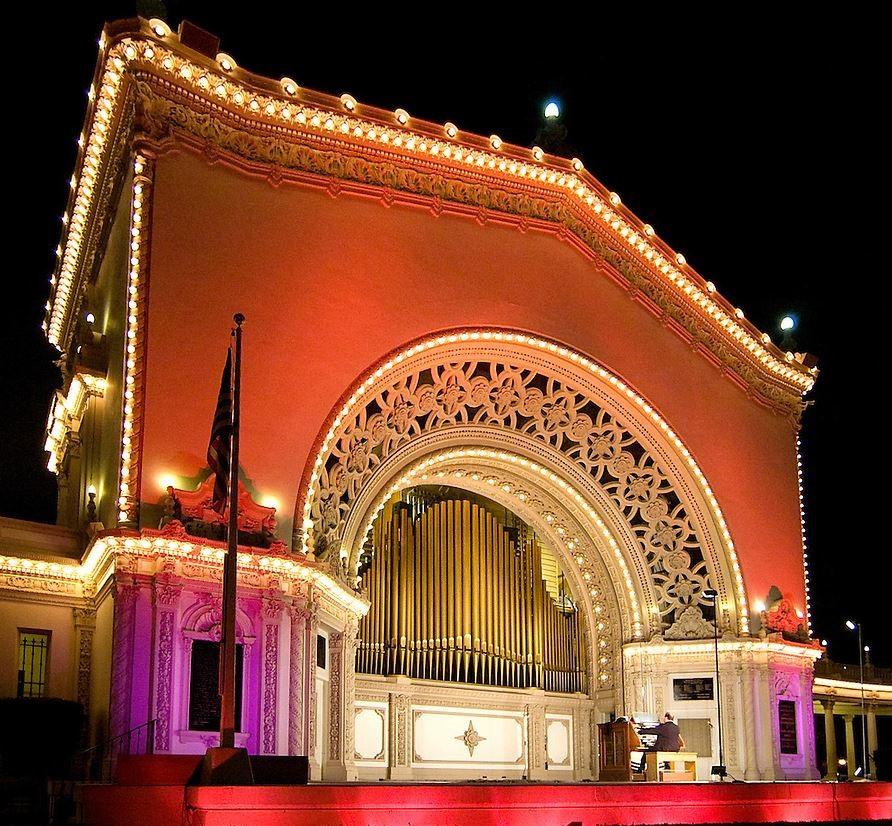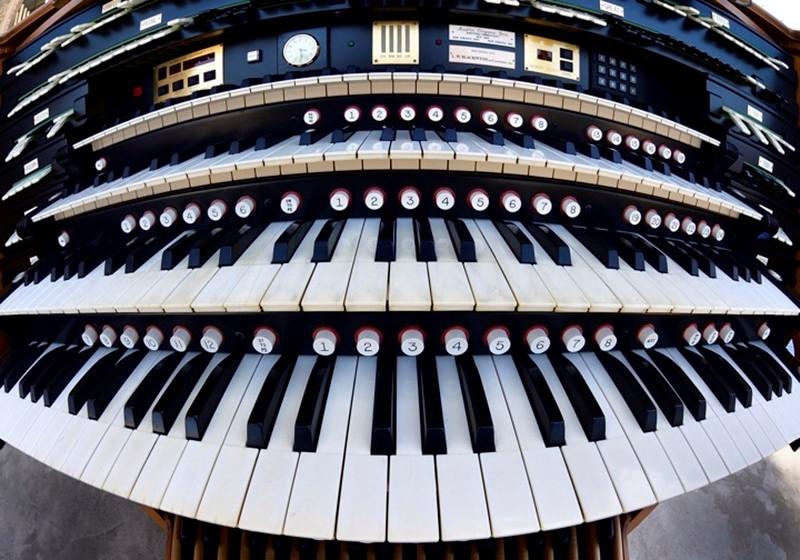SOS-0004 August 2022 – Part 4 – Organ Societies / Covid / Spreckels Organ Future COPPER MAGAZINE / Frank Doris / Issues 154 and 155
August 2022 – Part 4 – Organ Societies / Covid / Spreckels Organ Future
COPPER MAGAZINE / Frank Doris / Issues 154 and 155
Earlier this year, our own Gordon Stanley, Vice President for Spreckels Organ Society , had an opportunity to sit down with Frank Doris , Editor of Copper Magazine , to discuss the Spreckels Organ. The following text is taken directly from Mr. Doris's two-part January 2022 Copper Magazine series: The Spreckels Organ : A Historic Musical Treasure .

“Frank Dorris: In a previous conversation you had mentioned that there are a number of international organ societies and organizations. Can you tell us what some of them are?
GS: The one I know the most is the American Guild of Organists, which has chapters in almost every major US city. This past year they held a virtual convention with concerts recorded at some of the top organs in the country. Raúl was the featured organist of the convention and played the Spreckels Organ . I had the honor of producing Raúl's recording and that of Jaebon Hwang, the organist at San Diego's First United Methodist Church. {She] played the Sanctuary Pipe Organ, built by Lyle Blackinton, the largest in San Diego with 6,042 pipes.
Another important organization is the Associated Pipe Organ Builders of America, a group that focuses on supporting the art and upcoming generations of builders. There's the American Organ Academy , and the American Theater Organ Society has an active chapter in San Diego, with their own Wurlitzer that they share with a church in the area.
The Balboa Performing Arts Theater Foundation maintains the Wonder Morton organ in the Balboa Theater in downtown San Diego.
FD: How has COVID-19 affected your operations?
GS: We were exceptionally lucky to have seen COVID coming. We started live premiere concerts the week before the city shut down Balboa Park by assembling a small group of volunteers and maintaining our own social bubble. We had to shut down the Society's International Organ Festival, normally held each summer. But we were able to relaunch this program on a limited scale last fall. And we had to stop the fifth-grade student program and contest we hold with the American Guild of Organists [to showcase] rising stars. I miss the student programs the most and am excited about the possibilities of reinventing the programs in 2022.
Our loyal members stayed with us and actually increased their giving by 30 percent. The past 12 months have been amazing in terms of large gifts, bequests, and a matching challenge grant that will allow us to do much more outreach in the near future.
I like to think of Spreckels as the seed that planted the desire for culture and live music in San Diego, for in this past year, the Rady Shell was completed, the San Diego Symphony Orchestra pops program received an $85 million enhancement, and the Conrad Prebys Performing Arts Center was launched, a $42 million new live music venue in La Jolla focused on chamber and small-format classical music. Additionally, the symphony, opera, and theater are all in strong positions, and the pop, rock, jazz and blues scenes are making slow but creative comebacks. So, as you can see, I feel that COVID, while it has been temporarily devastating, has also seeded an environment of creativity and steadfastness where those of us who love live music refuse to be held back.

The crowd at a concert at the Spreckels Organ Pavilion
FD: What do you foresee happening in the future?
GS: This is my favorite question. Throughout San Diego's history, we have been blessed by men and women of immense foresight. People like John D. Spreckels, Malin Burnham, Bob Beyster, William Kettner, Alonzo Horton, Audrey Geisel, Joan Kroc, Irwin Jacobs, Jonas Salk, Ernest Rady, and Conrad Prebys. These people and others succeeded because their vision for the city extended decades beyond the latest quarterly earnings, and after earning their fortunes, they gifted it back to the citizens in ways that improved our lives through innovations in medicine, air transportation, electronics and biomedical science . Additionally, they made space for education and the arts, helping start and fund the major cultural institutions that define a world-class city.
Today the city is beginning to emerge from the COVID pandemic. We have seen similar events with the Spanish flu in 1918 and the polio outbreaks in the 1950s. In each case we survived [and became] a little wiser. This time we are truly experiencing the impact of a planet so well-connected that national borders no longer offer protection. I foresee that we will continue to stumble and hopefully learn some valuable lessons so that next time, and there will be a next time, we are better prepared to cooperate and help one another. Two bright spots I see are the wondrous new medical opportunities that will likely arise from [what we've learned], and the absolutely creative brilliance I have seen in the entertainment and music industries,
I hope when we look back five to 10 years from now, we can say [that] while we stumbled quite dramatically in the beginning, in the end, our reaction to and growth as a species that resulted from [our dealing with] the pandemic it was quite remarkable.
Regarding the Spreckels Organ and the Society, I see bright days ahead. Here are just a few of the ideas being discussed among the trustees, with an eye toward the second hundred years of the Spreckels Organ.
- An expanded audience and Society membership, and more volunteers who are energized and looking forward to helping with outreach projects.
- A multi-year endowment campaign to set aside funds for the full and permanent protection of professional positions, the maintenance of the body, and the continued expansion of programs.
- An enhanced collaboration with the Balboa Park leadership and other cultural organizations whereby we offer more collaborative performances and events.
- An expanded giving program that makes it easier for donors to direct funds and requests to specific projects.
- An expanded schedule of performances, a time when we have the resources to manage both live and high-quality pre-recorded concerts, to aid fans around the world and those unable to physically attend.
- A greatly expanded series of educational programs for young people and rising stars. This may include an academy where the best and brightest are invited for intense workshops on organ performance, design, and building.
- A transition from CDs and DVD media to downloadable high-resolution music in DSD and PCM formats.
Two years ago, before the pandemic [hit], up-and-coming members and officers of the Society's Board of Trustees met for a solid day of brainstorming and planning. Shortly, we expect to repeat this event and put steps in place to further expand our reach and the way we address our mission to preserve, protect and promote the Spreckels Organ and all it means, in terms of continuing to offer quality live music to the citizens of San Diego and the world at no charge.

Wide angle view of the Spreckels Organ.
FD: Is there anything else you'd like to tell us that would be of interest?
GS: If you ever have a chance to closely study an organist in the midst of a performance, you will see a true athlete in both the mental and physical sense of the word. To play the more complex pieces, the organist must have the ability to disconnect [the] normal brain activity that synchronizes the hands and feet. This is the ultimate form of walking and chewing gum at the same time! Each foot plays bass notes in different rhythms and the two hands go off on their own, tickling the keys of two or more keyboards, again in different rhythms. And then, in between notes, the organist adjusts stops to change instrumentation and on occasion turns the pages of the music. On complex performances, the organist often has an assistant to turn pages and adjust stops. Practicing the necessary 5 to 6 hours a day to stay in performance shape takes a toll on the organist's physique, straining the back, core muscles, wrist, and tendons up and down the arm and in the ankles. Most organists I know have a strict physical conditioning program with swimming, yoga, stretching and so on to prevent permanent damage to their bodies, and the top performing organists train [in a manner] similar to an Olympic athlete.
I would like to close by noting that the Spreckels Organ has been in continuous use for 107 years, and the Society came into being in 1988 when the very existence of the organ was threatened. John D. Spreckels and his brother di lui were true visionaries when they established the gift of offering live music at no charge to the citizens of San Diego and the world. Music truly is a universal language that can help heal the world, but we have to start with young people, get them involved, and let them see the power of good live music. Without these seeds, all the other cultural events that charge admission will wither because there will be no audiences. I would like to dedicate this article to the 1,000-plus Society members from all over the country and world, the trustees, and the officers and the professional staff that make this gift keep giving.”

President Herbert Hoover speaks at the Spreckels Organ Pavilion in 1935.
Acknowledgments: Special thanks to Jean Samuels, 2019 – 2021 Society president; Dale Sorenson, curator; Mitch Beauchamp, trustee; and Robert E. Lang, photographer, who were instrumental in making this article and interview happen.
Color photos courtesy of Robert E. Lang, USN (Ret.), Spreckels Organ Society, and Gordon Stanley. Black and white photo courtesy of the San Diego History Center.
Continued in part 5.
